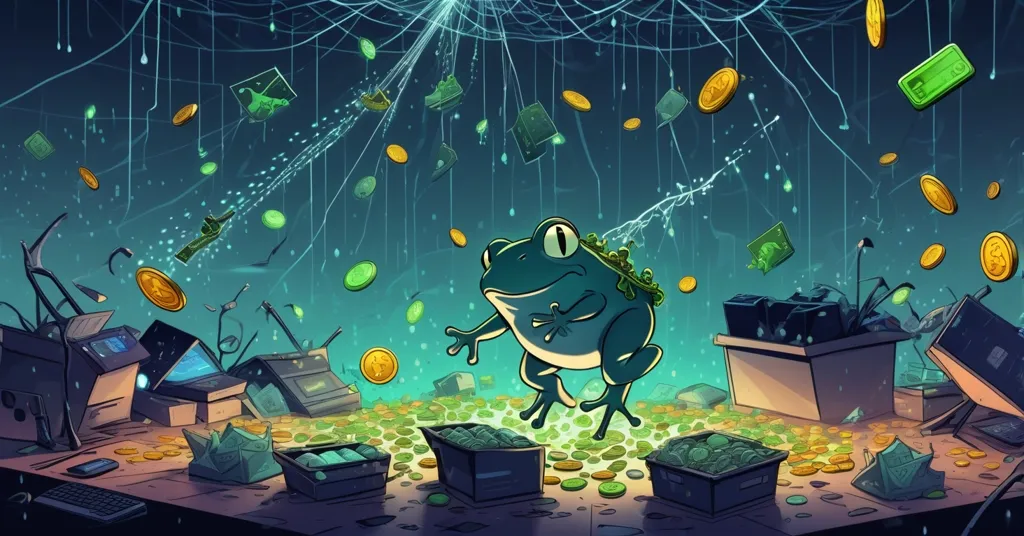Pepe ($PEPE) Whale Sell-Off Sparks Crash Fears: Rebound or Ruin in 2024?

Pepe ($PEPE) Whale Sell-Off Fears: Meme Coin Crash or Rebound in 2024?
Pepe ($PEPE), the frog-faced meme coin that captured the internet’s imagination, is now staring down the barrel of a potential market bloodbath. With exchange inflows skyrocketing—pointing to whales gearing up to dump—and trader interest in futures collapsing, the token’s future looks grim. Yet, a technical lifeline lingers at a key support level. Meanwhile, a new frog-themed project, Pepenode ($PEPENODE), is making waves with a gamified mining twist, raising millions in presale. Is this the next big thing or just another speculative trap? Let’s dissect the chaos of meme coins with a no-nonsense lens.
- Whale Alarm: PEPE tokens on exchanges spiked from 250 trillion to 258 trillion in 30 days, a red flag for sell-offs (Nansen data).
- Futures Fade: Open interest in PEPE futures dropped from $1 billion in July to $165 million, showing waning confidence.
- Price Pain: Down 77% in 2024, PEPE lags among top meme coins, but a support at $0.0000040 offers faint hope.
- New Frog Hype: Pepenode ($PEPENODE), a mine-to-earn game, pulls in millions in presale, promising virtual crypto mining.
Pepe ($PEPE) on the Brink: Whale Sell-Off Signals
For those unfamiliar, Pepe ($PEPE) is a meme coin—a type of cryptocurrency often fueled by viral internet culture rather than deep tech fundamentals. Inspired by Pepe the Frog, a character born from online comics and later co-opted into countless memes, PEPE rode a wave of hype earlier in 2024. But the tide has turned, and it’s not pretty. Blockchain analytics platform Nansen reports that PEPE tokens held on exchanges have surged from 250 trillion on November 6 to 258 trillion now, a 30-day peak. In crypto terms, this is a screaming warning. Whales—big holders with enough tokens to sway markets—are likely moving their stash to exchanges to sell. Think of them as major shareholders in a company: when they dump stock, prices crater, and retail investors get crushed in the stampede. This kind of activity often precedes sharp declines, and with PEPE already battered, the outlook is bleak. For deeper insights into what insiders might know about PEPE’s price movements, the data paints a troubling picture.
Compounding the problem, open interest in PEPE futures has imploded. Open interest is the total value of unsettled derivative contracts, a snapshot of how much skin traders have in the game. At its July high, PEPE futures hit $1 billion, a sign of wild speculative fervor. Today, it’s down to a measly $165 million, per market data. That’s not just a retreat; it’s a full-scale evacuation. Traders—especially the risk-loving crowd often called “degens” (short for degenerates, those who gamble on high-risk plays)—are losing faith. When sentiment sours this fast, it’s a death knell for tokens that thrive on hype over utility. PEPE’s price reflects this carnage: it’s lost 77% of its value since January, making it one of the worst performers among the top five meme coins like Dogecoin and Shiba Inu. If you tossed $1,000 into PEPE at the year’s start, you’d be left with a sad $230 now. That’s the kind of math that keeps investors up at night.
Historically, meme coins follow a brutal cycle: skyrocket on viral buzz, then crash when the party ends. Dogecoin’s 2021 pump-and-dump, fueled by celebrity tweets, and Shiba Inu’s meteoric rise followed by a steep fall are textbook cases. PEPE seems to be tracing the same arc, with whale movements amplifying the downward spiral. This isn’t just a token issue; it’s a glimpse into the fragility of speculative crypto niches where liquidity is thin and manipulation runs rampant. While Bitcoin builds a fortress of decentralization, meme coins are the chaotic skirmishes on the frontier—necessary for experimentation, sure, but often bloody for the unprepared.
A Glimmer of Hope: Support Levels and Rebound Potential
Before we write PEPE’s obituary, there’s a faint pulse worth noting. On the weekly price chart, the token is nearing a critical support level at $0.0000040, close to what traders call a “fair value gap” (FVG) from February 2024. An FVG is a price zone where little trading happened, often acting like a vacuum that pulls prices back to “fill” it before reversing. In simpler terms, it’s a spot where buyers might see the token as a bargain and jump in, potentially sparking a bounce. If PEPE hits this mark, we could see a short-term rally—emphasis on “could.” Meme coins don’t always play by technical rules; they’re more swayed by community vibes or a rogue influencer’s tweet than by chart patterns.
Above this support, there’s a resistance level around $0.0000060 that PEPE would need to break to signal real recovery. Resistance is a price point where selling pressure often halts upward moves—think of it as a ceiling. Breaking it could draw more buyers, but with whale sell-offs looming, that’s a tall order. What might catalyze a turnaround? A stabilizing Bitcoin price often lifts altcoins, including meme tokens, as market confidence spills over. Alternatively, a viral campaign or major endorsement—say, a big-name crypto figure hyping PEPE—could reignite interest. But let’s play devil’s advocate: meme coins have defied logic before. Even with dismal data, a random wave of FOMO (fear of missing out) from retail investors could pump PEPE overnight. The flip side? Whales dumping at the first sign of recovery could smother any rally. It’s a coin toss, and the house usually wins.
Pepenode ($PEPENODE): A New Meme Coin Challenger
While PEPE flounders, another frog is hopping into the fray. Pepenode ($PEPENODE) is a fresh project tied to the same Pepe the Frog meme but with a novel angle: it’s a mine-to-earn game that turns crypto mining into a virtual playground. Traditional mining—solving complex math to validate blockchain transactions—requires pricey hardware and eats electricity like a beast. Pepenode ditches that, letting players “mine” meme coins using virtual servers within the game. No rigs, no bills, just clicks and rewards. The concept has struck a chord, with millions raised in its presale phase, a testament to the hunger for gamified crypto experiences among retail investors.
The project packs features to lure players and speculators alike. Referral boosts encourage users to rope in friends, growing the community. Anti-bot protection aims to keep gameplay fair by blocking automated scripts. A token burn program is a standout: up to 70% of $PEPENODE tokens used to upgrade virtual mining rigs are destroyed, cutting supply over time. Think of it like a company buying back shares to boost value by reducing what’s out there—except in crypto, it’s often more hype than guarantee. Top miners on leaderboards also snag airdrops of $PEPE and $BONK, another meme coin, as extra incentives. You can buy $PEPENODE with USDT, ETH, or bank cards via their official site, with wallets like Best Wallet suggested for smooth transactions.
But let’s not get swept away. Gamification isn’t new—projects like Axie Infinity pioneered play-to-earn models, blending gaming with crypto rewards. Axie soared in 2021 but later stumbled as token inflation outpaced user growth, leaving many players underwater. Pepenode’s mine-to-earn twist could democratize mining access for non-techies, aligning with decentralization’s push to empower the little guy. Yet, without a track record, it’s a gamble. Will it sustain long-term engagement, or just attract presale speculators who dump at launch? And could its rise siphon liquidity from $PEPE, worsening the original frog’s woes, or might it revive interest in this meme sub-niche? The jury’s out, and skepticism is warranted.
Risks and Reality: Navigating the Meme Coin Minefield
Let’s cut the crap: meme coins are a high-stakes casino, and the odds aren’t in your favor. PEPE’s 77% plunge this year isn’t a fluke; it’s a reminder that these tokens can vaporize capital faster than a bad Vegas bet. Volatility is baked in—prices swing on whims, not fundamentals. Presales like Pepenode’s carry their own poison: they’re often puffed up with promises of moonshots, but many flop or turn out to be straight-up scams. Rug pulls—where developers abandon a project after pocketing funds—are a real threat. Even if legit, unproven projects can collapse under poor execution or market indifference. Investing here isn’t a strategy; it’s a dice roll where you could lose everything. End of story, no sugarcoating.
Zoom out, and meme coin dynamics expose deeper crypto flaws. Whale activity, as seen with PEPE, highlights how thin liquidity and concentrated holdings let big players jerk markets around. A single sell-off can trigger panic, a far cry from Bitcoin’s more robust, battle-tested infrastructure as a store of value. While altcoins and meme tokens fill speculative niches—onboarding new users with their low entry barriers and viral appeal—they often distract from crypto’s core mission of financial sovereignty and privacy. Bitcoin is the rebellion against centralized control; meme coins are the rowdy sideshow, entertaining but prone to self-destruction. And with regulatory eyes sharpening on crypto’s wild corners, tokens like PEPE could face added heat if deemed pure speculation with no utility. It’s a swamp—tread lightly.
What’s Next for Meme Coins?
Peering into the future of meme coins feels like reading tea leaves during a storm. Community fatigue is a growing risk—how many frog or dog tokens can investors stomach before hype wears thin? Regulatory scrutiny is another shadow; governments cracking down on speculative assets could clip meme coins’ wings, especially those with no clear use case. On the flip side, their chaotic energy keeps drawing newcomers to crypto, serving as a gateway to deeper exploration of decentralization. But do they help or hinder mainstream adoption? If Bitcoin and blockchain are to reshape finance, meme coin crashes risk painting the space as a joke to skeptics. Still, their defiance of norms—sticking a middle finger to traditional systems—echoes the disruptive spirit we champion. The question is whether that spirit survives the inevitable growing pains.
Key Takeaways and Questions for Crypto Enthusiasts
- What’s fueling fears over Pepe ($PEPE) price trends?
Whale activity, with exchange-held tokens jumping from 250 trillion to 258 trillion in 30 days, signals a looming sell-off, while futures open interest falling from $1 billion to $165 million shows trader confidence evaporating. - Could Pepe ($PEPE) stage a comeback?
There’s a chance if it reaches the $0.0000040 support near a fair value gap from February 2024, potentially attracting bargain hunters, though whale dumps and sentiment could derail any recovery. - What is Pepenode ($PEPENODE), and why is it turning heads?
It’s a mine-to-earn game linked to the Pepe meme, allowing virtual meme coin mining without hardware, with millions raised in presale thanks to features like token burns and airdrop rewards. - Does Pepenode’s token burn feature boost its value potential?
Burning up to 70% of tokens used for upgrades could increase scarcity and value if demand persists, but without proven adoption, it’s a speculative perk at best. - Are meme coins like PEPE and Pepenode worth the risk?
Hardly, unless you’re comfortable with extreme volatility; PEPE’s 77% drop this year and presale risks with Pepenode highlight the chance of losing everything in this speculative niche. - How do meme coins impact Bitcoin’s dominance?
They divert attention to speculative sideshows, often tarnishing crypto’s credibility with crashes, though they can onboard new users who might eventually explore Bitcoin’s deeper mission of financial freedom.
The meme coin arena is a wild ride, equal parts thrilling and treacherous. While I root for the anarchic vibe of tokens like PEPE—poking at the stale financial establishment—the hard data paints a sobering picture. Pepenode’s concept sparks curiosity, but untested projects are a minefield. As we push for decentralization and privacy in this space, remember: behind every viral frog lurks a swamp of risk. Keep your head on a swivel, question the hype, and think for yourself. The losses are real, but so is the potential to learn from this untamed frontier.



